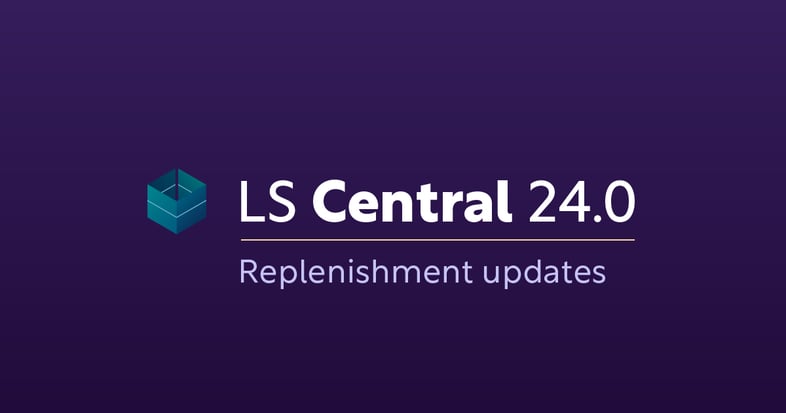LS Central 24.0: everything that’s new for replenishment

LS Central version 24.0 was released on April 9th, 2024. Here’s an overview of all the latest improvements to the replenishment functionality:
Excluding item groups from out-of-stock and replenishment calculation
It’s now possible for you to exclude an item from out-of-stock calculation. You can either exclude an item directly or exclude an entire item group, which is the division, item category, and retail product group. If you exclude the item group, the setting will be propagated down automatically to all the items belonging to the relevant group.
It is also possible to exclude an item group from replenishment calculation. Doing this will cause the setting to be propagated down to all the relevant items, making it easier to maintain the data.
Reorder point and maximum inventory for the warehouse
You can now specify parameters for maximum inventory and a reorder point for warehouse items in the replenishment journal calculation. When defined, the system will order the minimum or maximum warehouse inventory of the item when purchasing it to the warehouse. These settings are only applicable for the replenishment journal calculation that replenishes the warehouse, without cross docking.
Improved effective inventory handling
Because effective inventory is an essential part of replenishment calculation, we have introduced new ways to manage and handle this information.
Managing negative effective inventory in replenishment journal calculation
You now have the option to decide if the system should adjust the calculated effective inventory of the item from negative to zero during the replenishment journal calculation. This applies to the effective inventory in the warehouses and stores. For warehouses, this option is only applicable for purchase replenishment journals that replenish the warehouse.
Additionally, when the replenishment calculation is done with lead time enabled, the lead time sales quantity will be deducted from the item’s effective inventory to get the projected effective inventory. If the projected effective inventory is negative after the deduction, you can choose to let the value remain negative, so that you can order the full expected demand quantity during the lead time period.
Considering purchase return order in effective inventory calculation
We are offering a more complete solution for effective inventory calculation in replenishment where purchase return order is now considered part of the effective inventory for the item. You can choose to opt in or opt out the documents from the effective inventory calculation on the item, location, or the item store record level. When the coverage option is used, you can define how far back and how far into the future the purchase return orders should be considered during the calculation.
Improved cross docking calculation for purchase replenishment journal
We have improved the calculation workflow and introduced new setup fields to enhance the usability of the Purchase Replenishment Journal with Cross Docking.
Order quantity is now driven by quantity to cross dock and store stock coverage
We have streamlined the calculation workflow for cross docking in the purchase replenishment journal, where it is now driven by quantity to cross dock based on the related parameters for store stock coverage.
The quantity to cross dock will be rounded by the transfer multiple for each store, while the total order quantity will be rounded by the order multiple. After the rounding, if the total order quantity is less than the total quantity to cross dock, the quantity to cross dock will be brought down to match the order quantity, either using the default proportional distribution method, or using the replenishment transfer rules. As a result, you can be sure that the items are ordered according to their multiple values, and the maximum transferrable number of stock is cross docked to the stores.
Using replenishment transfer rules for quantity to cross dock redistribution
You can now use replenishment transfer rules in the purchase replenishment journal with cross docking. During the calculation, the transfer rule is applied when the total order quantity is less than the total quantity to cross dock, where the quantity to cross dock will be redistributed via the auto-single or auto-full method, according to the priority order of the store locations.
New warehouse parameters for cross docking calculation
We are offering a solution which lets you deal with the warehouse effective inventory in the cross docking calculation. You can now decide if the warehouse effective inventory should be deducted from the order quantity, or if it should be ignored so that you can order the full demand quantity for cross docking.
On the other hand, you can now define the inbound cross docking handling time for the warehouse, which may be different from the standard inbound warehouse handling time. When you’re using the replenishment coverage days profile for the dynamic coverage days calculation with lead time enabled, the inbound warehouse cross docking handling time will be used as part of the lead time calculation.
Skip zero lines functionality now works with scheduler-based replenishment journal calculation
If you use the skip 0 lines functionality in the replenishment journal, good news! We have extended the functionality to work with the scheduler-based calculation, so the system will stop creating replenishment journal lines without order quantity when the replenishment journal is calculated overnight with a scheduler job. Furthermore, the system will also stop creating replenishment journal detail lines with no order quantity when the skip 0 lines option is turned on.
New filtering options for sales history adjustment calculation rules
Sales history adjustment calculation rules support different rule types to increase or decrease the sales history quantity of an item in a store on a specific date. If you’re using sales history adjustment calculation rules of type item ledger entries and outlier detection, we have introduced a new option for you to filter the sales history calculation based on the replenishment calculation type of the items. For example, if you would like to include only items assigned with the calculation type of average usage in the calculation, this is now possible. We’re also introducing a more flexible calculation approach for sales history adjustment calculation rules of type item ledger entries. Instead of limiting the calculation to include only item ledger entries originating from sales orders, you now have the option to include the item ledger entries from all sales channels and sources.
Automatically populate the expected receipt date in the purchase order
You now have the option to automatically populate the expected receipt date of the purchase order based on the value from the purchase lines when the documents are created from the replenishment journal, replenishment stock demand worksheet, and allocation plan. You can also configure how the date field should be populated. It can be populated with the earliest or latest expected receipt date from the purchase lines, or you can choose to only populate the field if the date from all the purchase lines is the same. This will save you a lot of time as you don’t have to manually maintain the expected receipt date of the purchase order after it has been created.
Transfer unit of measure is now available
You can now specify a transfer unit of measure when creating transfer orders from the replenishment journal. You can configure the system so that when the document is created from the replenishment journal, the order quantity will be converted automatically to the specified transfer unit of measure if it fulfills the transfer multiple of the item.
Furthermore, you can have the transfer multiple field automatically updated with the quantity per unit of measure when the transfer unit of measure of the item is changed. The multiple field will also be updated when the quantity per unit of measure is changed, and the quantity changed belongs to the transfer unit of measure assigned to the item.
New mass data maintenance functionality in Replenishment Control Data list
The Replenishment Control Data List lets you maintain replenishment data within a list page that connects items, item store records, item distribution, and replenishment data profiles. We have now elevated the usability of the Replenishment Control Data List, by introducing even more mass data maintenance functionality. Assortment management is now much simpler and faster with the Replenishment Control Data List because you can now create the item store records for multiple items at once and copy the item distribution records from a source item to multiple destination items.

